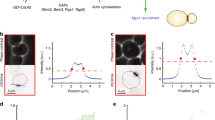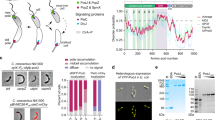Abstract
Many eukaryotic cell types undergo size-dependent cell cycle transitions controlled by the ubiquitous cyclin-dependent kinase Cdk1 (refs 1–4). The proteins that control Cdk1 activity are well described but their links with mechanisms monitoring cell size remain elusive. In the fission yeast Schizosaccharomyces pombe, cells enter mitosis and divide at a defined and reproducible size owing to the regulated activity of Cdk1 (refs 2, 3). Here we show that the cell polarity protein kinase Pom1, which localizes to cell ends5, regulates a signalling network that contributes to the control of mitotic entry. This network is located at cortical nodes in the middle of interphase cells, and these nodes contain the Cdk1 inhibitor Wee1, the Wee1-inhibitory kinases Cdr1 (also known as Nim1) and Cdr2, and the anillin-like protein Mid1. Cdr2 establishes the hierarchical localization of other proteins in the nodes, and receives negative regulatory signals from Pom1. Pom1 forms a polar gradient extending from the cell ends towards the cell middle and acts as a dose-dependent inhibitor of mitotic entry, working through the Cdr2 pathway. As cells elongate, Pom1 levels decrease at the cell middle, leading to mitotic entry. We propose that the Pom1 polar gradient and the medial cortical nodes generate information about cell size and coordinate this with mitotic entry by regulating Cdk1 through Pom1, Cdr2, Cdr1 and Wee1.
This is a preview of subscription content, access via your institution
Access options
Subscribe to this journal
Receive 51 print issues and online access
$199.00 per year
only $3.90 per issue
Buy this article
- Purchase on Springer Link
- Instant access to full article PDF
Prices may be subject to local taxes which are calculated during checkout




Similar content being viewed by others
References
Mitchison, J. M. Growth during the cell cycle. Int. Rev. Cytol. 226, 165–258 (2003)
Jorgensen, P. & Tyers, M. How cells coordinate growth and division. Curr. Biol. 14, R1014–R1027 (2004)
Rupes, I. Checking cell size in yeast. Trends Genet. 18, 479–485 (2002)
Dolznig, H., Grebien, F., Sauer, T., Beug, H. & Müllner, E. W. Evidence for a size-sensing mechanism in animal cells. Nature Cell Biol. 6, 899–905 (2004)
Bähler, J. & Pringle, J. R. Pom1p, a fission yeast protein kinase that provides positional information for both polarized growth and cytokinesis. Genes Dev. 12, 1356–1370 (1998)
Nurse, P., Thuriaux, P. & Nasmyth, K. Genetic control of the cell division cycle in the fission yeast Schizosaccharomyces pombe . Mol. Gen. Genet. 146, 167–178 (1976)
Nurse, P. Genetic control of cell size at cell division in yeast. Nature 256, 547–551 (1975)
Ubersax, J. A. et al. Targets of the cyclin-dependent kinase Cdk1. Nature 425, 859–864 (2003)
Morrell, J. L., Nichols, C. B. & Gould, K. L. The GIN4 family kinase, Cdr2p, acts independently of septins in fission yeast. J. Cell Sci. 117, 5293–5302 (2004)
Wu, J. Q., Kuhn, J. R., Kovar, D. R. & Pollard, T. D. Spatial and temporal pathway for assembly and constriction of the contractile ring in fission yeast cytokinesis. Dev. Cell 5, 723–734 (2003)
Paoletti, A. & Chang, F. Analysis of mid1p, a protein required for placement of the cell division site, reveals a link between the nucleus and the cell surface in fission yeast. Mol. Biol. Cell 11, 2757–2773 (2000)
Wu, L. & Russell, P. Nim1 kinase promotes mitosis by inactivating Wee1 tyrosine kinase. Nature 363, 738–741 (1993)
Parker, L. L., Walter, S. A., Young, P. G. & Piwnica-Worms, H. Phosphorylation and inactivation of the mitotic inhibitor Wee1 by the nim1/cdr1 kinase. Nature 363, 736–738 (1993)
Coleman, T. R., Tang, Z. & Dunphy, W. G. Negative regulation of the wee1 protein kinase by direct action of the nim1/cdr1 mitotic inducer. Cell 72, 919–929 (1993)
Breeding, C. S. et al. The cdr2+ gene encodes a regulator of G2/M progression and cytokinesis in Schizosaccharomyces pombe . Mol. Biol. Cell 9, 3399–3415 (1998)
Kanoh, J. & Russell, P. The protein kinase Cdr2, related to Nim1/Cdr1 mitotic inducer, regulates the onset of mitosis in fission yeast. Mol. Biol. Cell 9, 3321–3334 (1998)
Russell, P. & Nurse, P. The mitotic inducer nim1+ functions in a regulatory network of protein kinase homologs controlling the initiation of mitosis. Cell 49, 569–576 (1987)
Martin, S. G., McDonald, W. H., Yates, J. R. & Chang, F. Tea4p links microtubule plus ends with the formin for3p in the establishment of cell polarity. Dev. Cell 8, 479–491 (2005)
Padte, N. N., Martin, S. G., Howard, M. & Chang, F. The cell-end factor pom1p inhibits mid1p in specification of the cell division plane in fission yeast. Curr. Biol. 16, 2480–2487 (2006)
Celton-Morizur, S., Racine, V., Sibarita, J. B. & Paoletti, A. Pom1 kinase links division plane position to cell polarity by regulating Mid1p cortical distribution. J. Cell Sci. 119, 4710–4718 (2006)
Bähler, J. & Nurse, P. Fission yeast Pom1p kinase activity is cell cycle regulated and essential for cellular symmetry during growth and division. EMBO J. 20, 1064–1073 (2001)
Vavylonis, D., Wu, J. Q., Hao, S., O’Shaughnessy, B. & Pollard, T. D. Assembly mechanism of the contractile ring for cytokinesis by fission yeast. Science 319, 97–100 (2008)
Meyers, J., Craig, J. & Odde, D. J. Potential for control of signaling pathways via cell size and shape. Curr. Biol. 16, 1685–1693 (2006)
Bastiaens, P., Caudron, M., Niethammer, P. & Karsenti, E. Gradients in the self-organization of the mitotic spindle. Trends Cell Biol. 16, 125–134 (2006)
Moreno, S., Klar, A. & Nurse, P. Molecular genetic analysis of fission yeast Schizosaccharomyces pombe . Methods Enzymol. 194, 795–823 (1991)
Bähler, J. et al. Heterologous modules for efficient and versatile PCR-based gene targeting in Schizosaccharomyces pombe . Yeast 14, 943–951 (1998)
Cristea, I. M., Williams, R., Chait, B. T. & Rout, M. P. Fluorescent proteins as proteomic probes. Mol. Cell. Proteomics 4, 1933–1941 (2005)
Sreenivasan, A. & Kellogg, D. The Elm1 kinase functions in a mitotic signaling network in budding yeast. Mol. Cell. Biol. 19, 7983–7994 (1999)
Celton-Morizur, S., Bordes, N., Fraisier, V., Tran, P. T. & Paoletti, A. C-terminal anchoring of mid1p to membranes stabilizes cytokinetic ring position in early mitosis in fission yeast. Mol. Cell. Biol. 24, 10621–10635 (2004)
Acknowledgements
We thank members of the Nurse laboratory for discussions and critical reading of the manuscript, A. Puszynska for technical assistance, The Rockefeller University Bio-Imaging Resource Center for assistance with microscopy, The Rockefeller University Proteomics Resource Center for mass spectrometry, K. Gould, J.-Q. Wu, T. Pollard, J. Bähler, F. Chang and K. Sawin for yeast strains, plasmids and antibodies, and S. Martin for sharing unpublished data and for discussions. J.B.M. was supported by a postdoctoral fellowship from the American Cancer Society (PF-07-129-01-MBC); A.P. by funding from ANR (BLAN06-3_135468), ARC (no. 4934) and FRM (INE20071110973); and P.N. by the Breast Cancer Research Foundation and The Rockefeller University.
Author information
Authors and Affiliations
Corresponding author
Supplementary information
Supplementary Information
This file contains Supplementary Figures S1-S13 with Legends and Supplementary Tables S1-S4. (PDF 5560 kb)
Rights and permissions
About this article
Cite this article
Moseley, J., Mayeux, A., Paoletti, A. et al. A spatial gradient coordinates cell size and mitotic entry in fission yeast. Nature 459, 857–860 (2009). https://doi.org/10.1038/nature08074
Received:
Accepted:
Published:
Issue Date:
DOI: https://doi.org/10.1038/nature08074
This article is cited by
-
Pomegranate: 2D segmentation and 3D reconstruction for fission yeast and other radially symmetric cells
Scientific Reports (2020)
-
Functional interaction between Cdc42 and the stress MAPK signaling pathway during the regulation of fission yeast polarized growth
International Microbiology (2020)
-
Fission yeast type 2 node proteins Blt1p and Gef2p cooperate to ensure timely completion of cytokinesis
BMC Molecular and Cell Biology (2019)
-
Cell size sensing—a one-dimensional solution for a three-dimensional problem?
BMC Biology (2019)
-
Molecular mechanisms of temperature acclimation and adaptation in marine diatoms
The ISME Journal (2019)
Comments
By submitting a comment you agree to abide by our Terms and Community Guidelines. If you find something abusive or that does not comply with our terms or guidelines please flag it as inappropriate.



